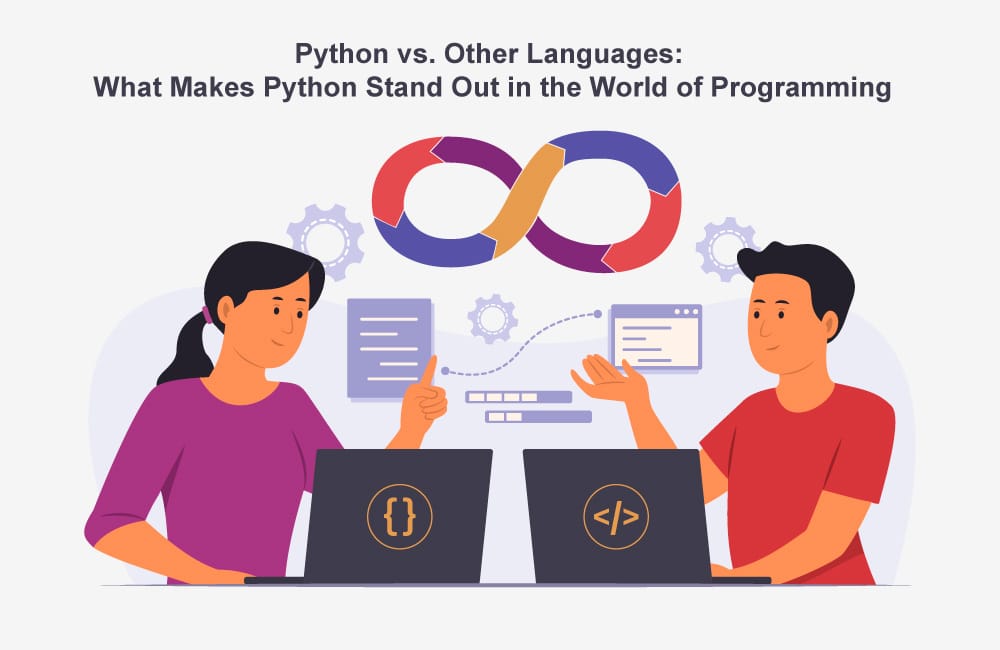What Makes Python Stand Out in the World of Programming
A well-liked and adaptable programming language is Python. Although It may not be the greatest solution for every programming activity (such as low-level systems programming), it is a fantastic choice for a variety of applications and skill levels thanks to its simplicity, adaptability, and robust ecosystem. It is simpler to write and comprehend code because of its legible, intuitive syntax. This motivates developers to concentrate on finding solutions rather than getting bogged down in complicated syntax.
It has a sizable and vibrant developer community, therefore, there is a tonne of tools, libraries, frameworks, and resources accessible to assist you in finding effective solutions. This opens up numerous chances for cooperation and support. It showcases its remarkable versatility by fulfilling a wide array of functions, encompassing domains such as web development, data analysis, scientific computing, artificial intelligence, machine learning, automation, and beyond. This proficiency enables developers to seamlessly navigate between diverse roles and projects, obviating the necessity of mastering disparate programming languages.
Python enjoys extensive availability across a range of operating systems, including Windows, macOS, and Linux, as well as diverse architectures. This ubiquity facilitates the creation of cross-platform programs with minimal need for substantial modifications. Furthermore, It’s open-source nature ensures that its source code is readily accessible to all, allowing unrestricted exploration and utilization. By enabling developers to alter and disseminate the language itself, this promotes collaboration, creativity, and personalization.

Why Python is Popular
Every language is created to provide its users with something unique from which they can gain something. This paradigm outlines the nature of Python programming. In certain contexts, It does not supplant low-level languages such as C or C++, which afford users greater control over CPU operations. Likewise, It does not serve as a substitute for Java, which is highly sought after for its capacity to develop intricate applications, or for JavaScript, which underpins the majority of websites.
However, it is more fair to compare it to C#, PHP, and Ruby because we can compare similar parameters directly and side by side. And the benefits of It that we highlight by examining the alternatives demonstrate the basis for its acceptance. We urge you to go and see it for yourself!
Where Python is used
There are several Python application cases in various industries. The development and testing of desktop, mobile, and internet apps immediately come to mind when considering the most common It usage. It, on the other hand, is a language with several applications.
Python is particularly strong in the following applications:
Web application creation
Data Science
Scripting
Programming databases
speedy prototyping
Python’s user base is expanding quickly since it is suitable for all programming languages. Examples include cross-platform shell scripting, quick automation, straightforward web development, data analysis and visualization, AI, and ML.
It is frequently used by experts to complete a range of jobs in several fields more effectively. Automation can be used to, among other things, improve performance. The main industries where individuals must perform tedious and repetitive jobs include finance, insurance, and marketing. These duties include downloading webpages, analyzing data, and examining, copying, renaming, and uploading information to servers. Instead, a programmer might automate everything with a It script.
Moreover, proficiency in Python is not confined exclusively to software engineers. The language supports data visualization and analysis. It offers a robust ecosystem that includes effective data processing libraries, supporting data scientists in carrying out difficult numerical computing tasks.
Python vs. Other Programming Languages
Given its declared purpose as a programming language that is helpful to developers and programmers, Python frequently refers to alternative programming languages like C#, Java, PHP, and Rails on Ruby. This comparative analysis retains its relevance as it encompasses factors such as performance, functionality, and other pertinent aspects inherent to the languages under scrutiny.
Python vs. Java
Java is rated first on the aforementioned TIOBE index. It has established a reputation for being the language most frequently used to develop Internet applications. Python can even exceed Java in terms of developer support, although Java developers have access to a significant number of libraries. Both languages, however, are widely renowned for being versatile. Java and Python do substantially different software development jobs in the same way. They both possess this.
While sharing certain similarities, Python and Java also exhibit notable distinctions. Primarily, Python functions as an interpreted language, whereas Java operates as a compiled language. Consequently, potential issues within It would manifest during runtime rather than during the compilation phase, as is the case with Java. Java is the official language for developing Android applications. It, on the other hand, does not prioritize the development of mobile apps, to put it mildly. That is warranted by a library named Kivy, but the development process is still problematic. It is a more productive programming language than Java, where everything must be explicitly defined, due to its interpretability.
There are always fewer lines of code in It than in Java to accomplish the same task since Java has an innate tendency towards verbosity. Finally, learning It is easier and more intuitive. Nevertheless, this does not deter beginners from learning Java, despite its additional coding.
Python vs. C#
We’ll start with the shared traits first. Python and C# represent programming languages that share functional and usability traits. Both languages exemplify middle-level object-oriented programming paradigms, distinguishing themselves by robustly supporting this approach, thereby fostering well-structured code. These languages serve as versatile and comprehensive solutions for creating a wide spectrum of applications, encompassing desktop, mobile, and cloud-based applications, as well as enterprise software and online applications.
Both are great options for site design. However, C# is mostly utilized for online development and Windows desktop applications. It is believed that Microsoft will continue to pay attention to and maintain the language’s relevance for the present day, as it is predictably the best fit for creating Windows products utilizing its.NET framework. The fact that C# code is compiled into native code is one of the greatest distinctions. Additionally, the compilation is challenging. The corresponding OS’s interpreter then interprets It after it has been first compiled into byte code.
This is a distinguishing quality of Python as a scripting language: flexibility and portability are gained at the expense of an explicit compilation stage. C# and Python have slightly different learning curves. While It offers a smoother learning curve, particularly advantageous for novices, C# presents a relatively modest learning curve. C# proves to be a more suitable selection for programmers possessing intermediate to advanced proficiency.
Python vs. C++
Python and C++ are different programming languages with different abilities and performances. a strong commitment to object-oriented programming. Numerous comparisons between Python and C++ lead to numerous conclusions. Python stands as an exemplary programming language for those new to the field, attributed to its straightforward syntax and code readability. Moreover, Python emerges as a superior choice for backend web development when compared to C++, a language less recognized for its widespread application in online programming.
Furthermore, Python commands a prominent position in the realms of data analysis and machine learning. In the domain of machine learning, It excels even in comparison to the capabilities of C++, underscoring its prowess in this arena. If simplicity is the most crucial feature you desire in a programming language, Python is the finest option. When it comes to AI and ML frameworks, they are considerably easier to use and have an excellent support system.
The syntax of C++ is complicated and tough to grasp and write. It mandates that the user follow specific coding rules, like the use of curly brackets and semicolons following statements. It, in contrast, lacks such programming conventions. Python, on the other hand, follows indentation norms similar to those found in the English language. Programmers may now understand Python code more easily. C++, as a statically typed programming language, requires variables to be declared before usage by defining their type and name. Because Python is a dynamically typed programming language, defining variables before using them is not required.
Python vs. PHP
The server-side scripting approach serves as the foundation for this pair of languages. They are therefore ideally suited to develop the backend of web applications. The extensive toolkit of Python has been discussed. Lavarel and Symfony are two examples of well-designed PHP web development frameworks. However, Python’s libraries are more sophisticated and well-organized. Both are interpretive, high-level, object-oriented systems. Consequently, Python’s syntax can be harnessed to convert PHP into native code. Nevertheless, a differentiation arises between the two languages concerning the practical implementation of object-oriented programming principles. Although PHP’s OOP is less organized, it strives to grow more organized over time.
The syntax is still another difficulty. Python places the most emphasis on simplicity. The syntax of PHP is similar to that of C-type languages, making it more challenging to comprehend. As a result of its more difficult learning curve, PHP is less enticing to beginners. The minimum requirements for getting started are understanding the fundamentals, OOP using PHP, design patterns, and frameworks, but PHP is not recommended due to potential learning obstacles, particularly while learning frameworks. In addition, Python is increasingly being used instead of PHP, which is now stagnant. Python is replacing PHP among programmers in increasing numbers due to its compelling advantages.
Python vs. Ruby
Ruby is frequently preferred by software professionals, who view it as a work of art and even enjoyable. For instance, OOP in Ruby allows users to define their methods, call methods on other objects, and modify methods as needed. This is the strength of the language. The issue is that Python is more widely used. It may only increase a programmer’s employability in 2019. The number of Python users and developers is currently increasing. Although both languages can brag about having clear syntax, Python is far more predictable. All components exhibit operational coherence and alignment.
In cases of deviation, the sources of error and their specific locations are readily discernible. Ruby’s grammar is more forgiving, but every time you write a line improperly, the interpreter picks up the slack and delivers the intended result. Anyway, there are numerous parallels between these two languages, which are both simple to learn. Ruby on Rails development is comparatively simple due to the abundance of resources.
Ruby is less popular than other programming languages outside of the Rails community, hence it is advised to learn another language first before diving into Ruby. It, extensively employed across a diverse spectrum of disciplines, serves as a focal point for numerous educational resources. Proficiency in It is imperative for those seeking to leverage data analytics in the development of machine learning models.
Conclusion
Python represents merely one among the array of programming languages accessible to developers. Each programming language possesses distinct merits, drawbacks, and areas of expertise. The task at hand, project needs, already-existing tools and libraries, individual preferences, and the industry you work in all play a role in determining which programming language to choose. While some developers prefer to focus on a single language, others pick up several to work on various project types. The ideal programming language for a particular project will ultimately depend on a mix of these variables.


